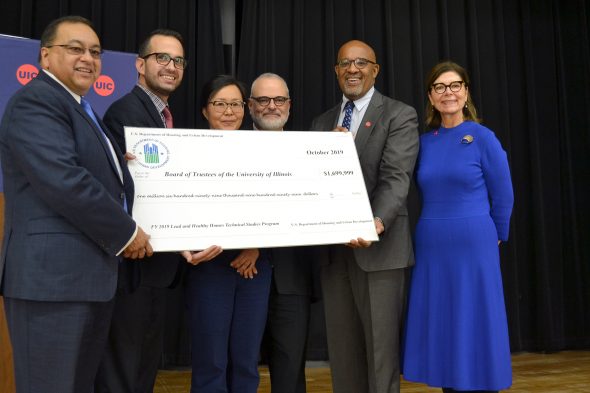UIC researchers awarded $1.7M from HUD

The University of Illinois at Chicago received $1.7 million in research funding from the U.S. Department of Housing and Urban Development to study lead and other household health hazards. The funds will support two different projects in Illinois communities.
UIC’s Samuel Dorevitch, associate professor of environmental and occupational health sciences at the School of Public Health, will be awarded up to $1 million through the Lead and Healthy Homes Technical Studies Program.
In this study, Dorevitch and colleagues will focus on lead in drinking water of homes that use private, on-site wells for drinking water. The research team, which will also include experts from the University of Illinois at Urbana-Champaign and Northern Illinois University, will work with the Illinois Department of Health and five local health departments to find ways to predict which homes with wells are most likely to have lead in their drinking water. After lead evaluations, researchers will test three interventions to remove the lead from the homes and analyze these methods for effectiveness and cost.
“Much of the recent focus on lead in drinking water has been in urban areas, such as Flint, Michigan, but this research will help residents of rural areas understand their risk of having lead in their well water,” Dorevitch said. “The findings should be useful to health departments in rural areas in developing guidance about effective ways to reduce lead exposure through well water.”
Through the Lead Technical Studies Program, UIC’s Apostolis Sambanis, adjunct assistant professor of environmental and occupational health sciences at the School of Public Health, will be awarded up to $700,000.
Sambanis and colleagues will use the funds to assist the Illinois Department of Commerce and Economic Opportunity’s Help Eliminate Lead Program, also known as HELP. HELP is a pilot program taking place in Galesburg, Illinois, where households living in pre-1978 built homes will be evaluated for lead risks. After water service line replacements and/or lead removal interventions, UIC will reevaluate households for lead risks. The researchers will use the data collected and input it into pre-established models to identify the best methods to reduce lead risk. This data will also be compared with urban lead risk studies to see if the model is consistent in performance outcomes.
Both of these studies are part of a greater initiative by HUD to improve the department’s and people’s knowledge of health and safety hazards in homes. Understanding how these hazards occur and finding cost-effective methods for removal are critical to protecting at-risk populations, like young children.
Written by Natasha Wadlington
